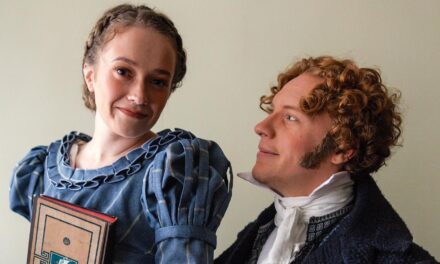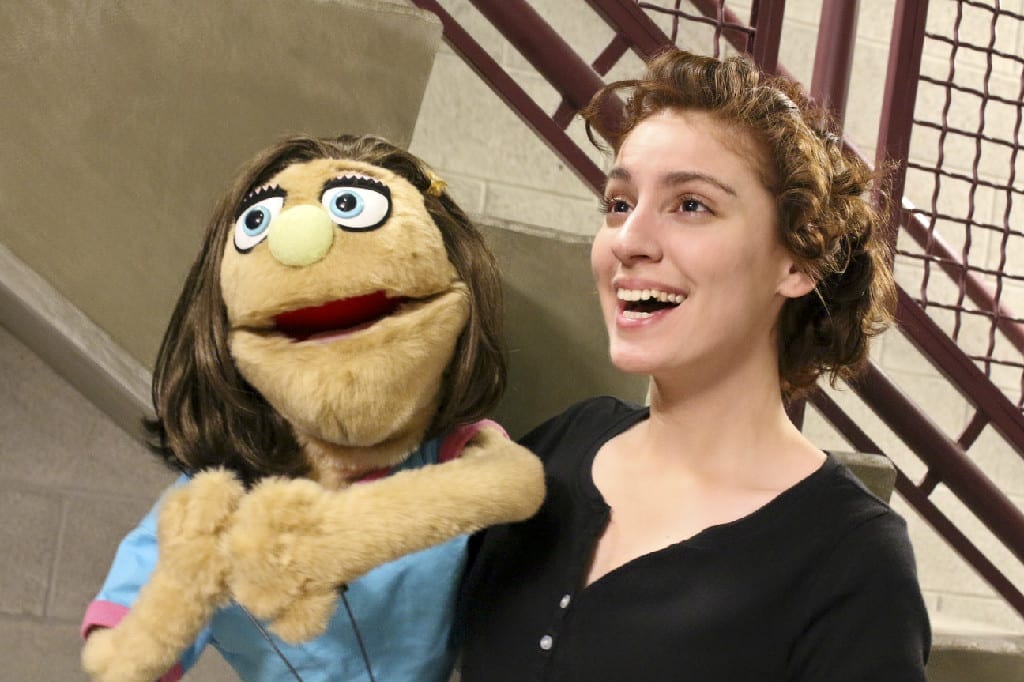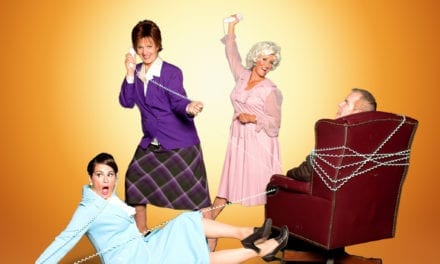SALT LAKE CITY — PYGmalion’s production of Julie Jensen’s Two-Headed, under the direction of Fran Pruyn, lives up to its reputation. If you haven’t actually heard of Two-Headed…, well, that would be shame. It is easily one of the best plays written by a Utah playwright, as is evidenced by its critical reception. Included in Best Plays by Women 2000 and winner of many awards including the LA Weekly award for best new play, Two-Headed is Jensen’s most-produced work. Moreover, Jensen herself has the honor of being the Utah playwright whose work is most frequently produced outside of the state. In fact, Two-Headed has been produced all across the United States as well as internationally. This production is only the play’s third time playing in Utah despite the locally significant subject matter.

Show closes November 23, 2019.
The setting for the play is Southern Utah following the Mountain Meadows Massacre. The Mountain Meadows Massacre is an historical event in which a group of emigrants traveling through Utah to California were besieged for three days by a band of Mormon men and then brutally murdered after being forced to give up their guns. 127 men, women, and children perished with only a handful of small children spared. This horrific event is a dark stain in Mormon history, not widely spoken of in Utah and almost completely unknown by audiences in other states. That the play would be so popular outside of Utah is a testimony to Jensen’s dramaturgy and to the universal truths the play points to in its specificity.
The play opens with Lavinia and Hettie as children as they wait for their friend Jane to come back from the pasture. While they wait, they discuss a two-headed calf supposedly in the root cellar until conversation turns to the emigrants from Missouri camped at nearby Mountain Meadows. It is revealed that they have been murdered for their sins: a blood atonement. In the next scene, ten years later, there has been another murder. Hettie has smothered Jane to death in a compassion killing after she had contracted rabies from an animal bite. This time the girls wait with Jane’s dead body nearby for Jane’s husband, Ezra, to come home from Church business so that they can bury her, and conversation turns again to the Massacre and the involvement of Lavinia’s father. Another decade goes by, and in the next scene it is discovered that Lavinia has married Ezra and Hettie has become the second wife of Lavinia’s father who is now in prison in Connecticut for his part in the killings. Ten years later, it is Hettie’s daughter (Lavinia’s half-sister) who is becoming the second wife of Lavinia’s husband, Ezra, and Lavinia finally admits her homosexuality. In the last scene, when the women are in their fifties, they discuss Ezra’s homecoming from prison, where he was sentenced for practicing polygamy, and Hettie finally discovers how much Lavinia really knows about the massacre so many years prior.

Haley McCormick Jenkins as Hettie and Brenda Hattingh as Lavinia. Photo by Beth Bruner.
While the intermarriages between these characters’ families may seem a bit contrived, I would suggest that truth is often stranger than fiction. In fact, when I interviewed Jensen about this play in 2008 while researching contemporary Mormon drama for my PhD dissertation, I discovered that much of this play came straight from Jensen’s own family history. Having grown up in Southern Utah, Jensen witnessed the two-headed approach to the Mountain Meadows Massacre by local Mormon families (they knew of its horror but spoke not of it). She knew stories of ancestors who had revolted against the suggestion that they enter into polygamy. Even the story of the mercy-killing of Jane following a rabid bite had come from her own family history. All of these events make for a good story, but more importantly, their truthfulness seeps into the message of the play, making it universal. In the end, this play is about women, “Brave, bold, and hardworking” (as Jensen describes the Southern Utah women to which the play is dedicated). It is a play about women confronting a suffocating patriarchy, battling it, raging against it, and overcoming it. It is a play that is often uncomfortable and irreverent, but Two-Headed is also funny, juxtaposing humor and tragedy into a dramatic creation that lives up to its title.
It is a tall task for actresses playing Hettie and Lavinia. With no intermission and five scenes spanning decades in the lives of the characters, it is a physically taxing play. Haley McCormick Jenkins as Hettie and Brenda Hattingh as Lavinia were excellent in their roles and in keeping the pace and energy of the production. Under Pruyn’s direction, the actresses’ characters were each other’s suitable foil. It is in this approach, however, that I take slight issue. Having read the script and seen a previous production, I believe the play would work better if the characters were less each other’s opposite. Both women survive their circumstance in a very different way, but their character development is more complex if we also see glimpses of their similarities (two-headed animals share the same body, after all). Lavinia’s “intensity” is mentioned multiple times in the play but never once seen in Hettie. Hettie’s resolute contentment is barely ever visible in Lavinia. So, too, Lavinia’s “intensity” is played far too loudly for far too long in this production. A quiet intensity is often more frightening than one at fever pitch. These criticisms aside (and my wish that the gut-wrenching final scene had been given more weighted silence), Pruyn’s direction was otherwise exemplary, extending, at times, even into the scene changes.

Haley McCormick Jenkins as Hettie and Brenda Hattingh as Lavinia. Photo by Beth Bruner.
Supporting Pruyn’s direction was the set design by Allen Smith, which utilized the ever-present root cellar housing the plundered treasures of the murdered emigrants, the witness-bearing tree, and the empty wooden crates (also suggestive of items taken from the wagon train). The lighting design by Pilar I was notable in its screen projections that punctuated each scene, and the soundscape design by Mikal Troy Klee was thought-provoking as the lyrics for the songs between each scene spoke in various ways of the stage action. Costume design by Maddiey Howell was unassuming and appropriate, assisting the women in suggesting the passage of time.
As a play, Two-Headed is deceptively simple: two characters with a minimal set and no special effects. This simplicity allows Jensen’s artful dialogue and skilled word-choice to take center stage. Under the direction of Pruyn, this play will also make you think harder about history, or, should I say, herstory? While there are other fine women playwrights that have also told the story of our culture and state from the female perspective, it might be said that Jensen is the pioneer (like her characters). She has not only created a foundation but continues to build on it. Don’t miss an opportunity to see this play, and check back with Pygmalion Productions; they announced a forthcoming talkback after one of the productions with Jensen and Mormon historian Will Bagley.

This review generously sponsored by a grant from the Salt Lake County Zoo, Arts, and Parks program.





